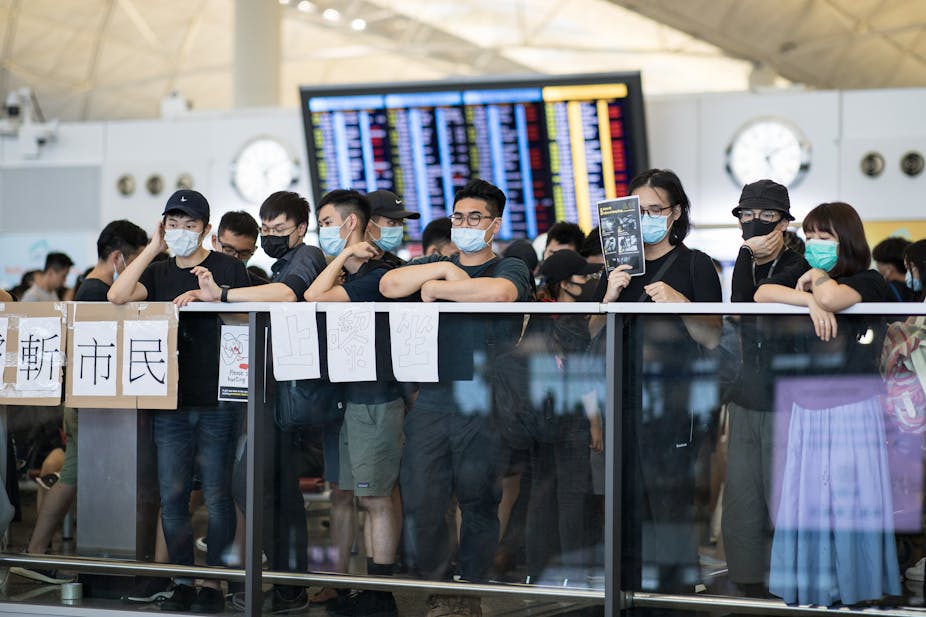Beijing has made no secret that it is weighing up the option of using force – either through deploying the People’s Liberation Army or People’s Armed Police – to quell the increasingly disruptive protests in Hong Kong. On August 12, Chinese state-media published footage of troops amassing in Shenzhen, near the border with Hong Kong.
At this stage, it’s still likely that Beijing is sabre-rattling to intimidate the Hong Kong government and the protesters. But the longer the demonstrations continue – and especially if the protesters become emboldened and more disruptive – the more Beijing will be tempted to use force.
This would be a mistake. Beijing would probably be able to easily quell the protests through intervening, but the costs of doing so would be high, both in Hong Kong and further afield.
As the Soviet Union’s interventions in Hungary in 1956 and Czechoslovakia in 1968 demonstrated, putting protests down is the easy part. The hard part is managing the long-term implications of doing so.
While the Soviet Union managed to impose relative stability in Hungary and Czechoslovakia until the late 1980s, the international costs of both interventions were large. Many left-leaning groups in the West which had been pro-Soviet up to that point, split over whether to support the intervention in Hungary. The issue caused a serious rift and cost the Soviet Union useful support behind “enemy” lines.
The Czechoslovakian intervention further eroded the Soviet Union’s moral standing, at a time when support in Western Europe for socialist ideals was at its height.
Given that Beijing has painstakingly attempted to choreograph its ongoing rise as a “peaceful” one under the leadership of Xi Jinping, presiding over a forceful crackdown in Hong Kong would severely undermine that narrative.
It would also hurt Beijing’s potential to emerge as an international leader, something Xi Jinping has targeted in the wake of the Trump administration’s recalibration of its international goals.
1967 riots
But there is a model at hand for how Beijing might handle the Hong Kong protests, and it, ironically, comes from Hong Kong itself. In 1967 Britain that was the domineering power and it was Chinese ideas that were the driver of protests in the territory.
At the time, Hong Kong was officially a British Crown colony and although Hong Kongers had certain civil liberties not available to those in mainland China, it was a colony and there were restrictions of freedoms. The 1967 riots were not so much a manifestation of discontent in Hong Kong at the time but more a spill-over from the turmoil occurring in China – namely the cultural revolution.
When a relatively minor labour dispute in a Hong Kong factory producing artificial flowers occurred in May 1967, pro-Communist trade unions – backed by Beijing and overtly helped the Red Guards – seized the opportunity and organised demonstrations which eventually snowballed into full on riots and terrorist attacks against British colonial rule.
The 1967 riots were much more violent than what has occured so far this year. Running for eight months in total, by the end of the unrest, 51 people had been killed.

It’s important not to make any equivalence between the groups behind the 1967 riots and those behind the demonstrations now, as the majority of the current protesters have largely maintained a non-violent approach. But, there is the potential for violent tactics to become more common as tensions worsen.
Beijing can learn some lessons from the British response to the 1967 riots. Given the scale of violence back then, it would not have been shocking if the British had taken extra steps to try and forcibly quell the rioting, especially given the role of instigators from outside the territory in stoking the flames.
Instead, the British government allowed the Hong Kong administration and police to treat the riots as an internal matter. This removed any opportunity for the rioters to cite heavy-handed British tactics to legitimise their actions.
As the demonstrations turned more violent, the British and the Hong Kong government won in the court of public opinion, a crucial step to ending the riots.
The benefits of non-intervention
Beijing’s problem right now in Hong Kong is that few people among the population there believe that Beijing is willing to honour the terms of the One Country Two Systems agreement – namely to allow Hong Kong to have significant autonomy, until at least 2047.
Conversely, many Hong Kongers have become nostalgic for the days of British rule because not only in the 1967 riots did Britain act with caution and sense, they worked to improve conditions for Hong Kongers in the 1970s and beyond.
For Beijing to reap the benefits of having Hong Kong within its gravitational field – and the benefits are many, but only if stability can be ensured – it needs to somehow build confidence with Hong Kongers.
Resisting the urge for a heavy-handed intervention and allowing the Hong Kong government to independently deal with the protests would have some short-term costs for Beijing, especially domestically in mainland China.
But, at the same time, non-intervention would have significant long term pay-offs for China, not only for its relationship with Hong Kong but more broadly its international image.

